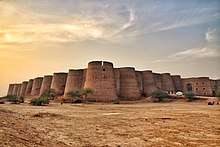Multan Fort
The Multan Fort, a military installation, was a landmark of South Asian defence and architecture. According to some estimates the original fort was built between 800 and 1000 B.C. It was built near the city of Multan by the Katoch dynasty, in Punjab province, on a hillock separated from the city by the Ravi River. The fort was destroyed by British forces during British colonial rule.
The fort was notable for both its effectiveness as a defence installation and for its architecture. Contemporary reports put the walls of the fort at 40 to 70 feet (21 m) high and 6,800 feet (2 km) in circumference. The fort's 46 bastions included two flanking towers at each of the four gates (the De, Sikki, Hareri and Khizri Gates). A ditch 25 feet (7.6 m) deep and 40 feet (12 m) wide and an 18-foot (5.5 m) glacis protected the fort from intruders.
Within the fort stood a citadel flanked by 30 towers, enclosing mosques, a Hindu temple and a Khan's palace. The citadel was severely damaged by the battering it got from the guns of Maharaja Ranjit Singh in 1818.
The Fort was originally known as Katochgarh and is attributed to have been built by the Katoch Dynasty.
Gates
There were four other gates which belong to Kohna Fort of Multan, out of which only first survives.
Qasim Gate
Khizri Gate
Sikhi Gate
Hareri Gate
See also
- List of UNESCO World Heritage Sites in Pakistan
- List of forts in Pakistan
- List of museums in Pakistan
